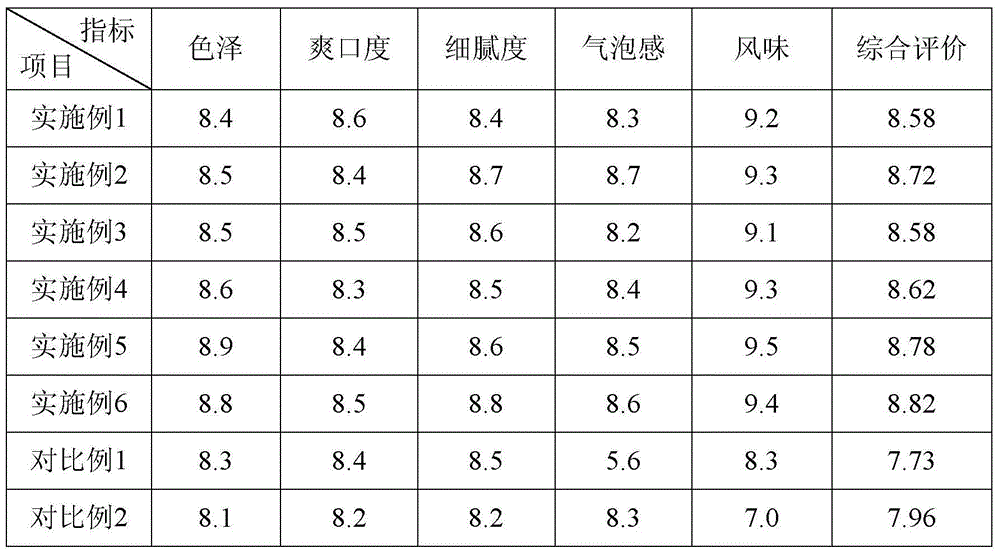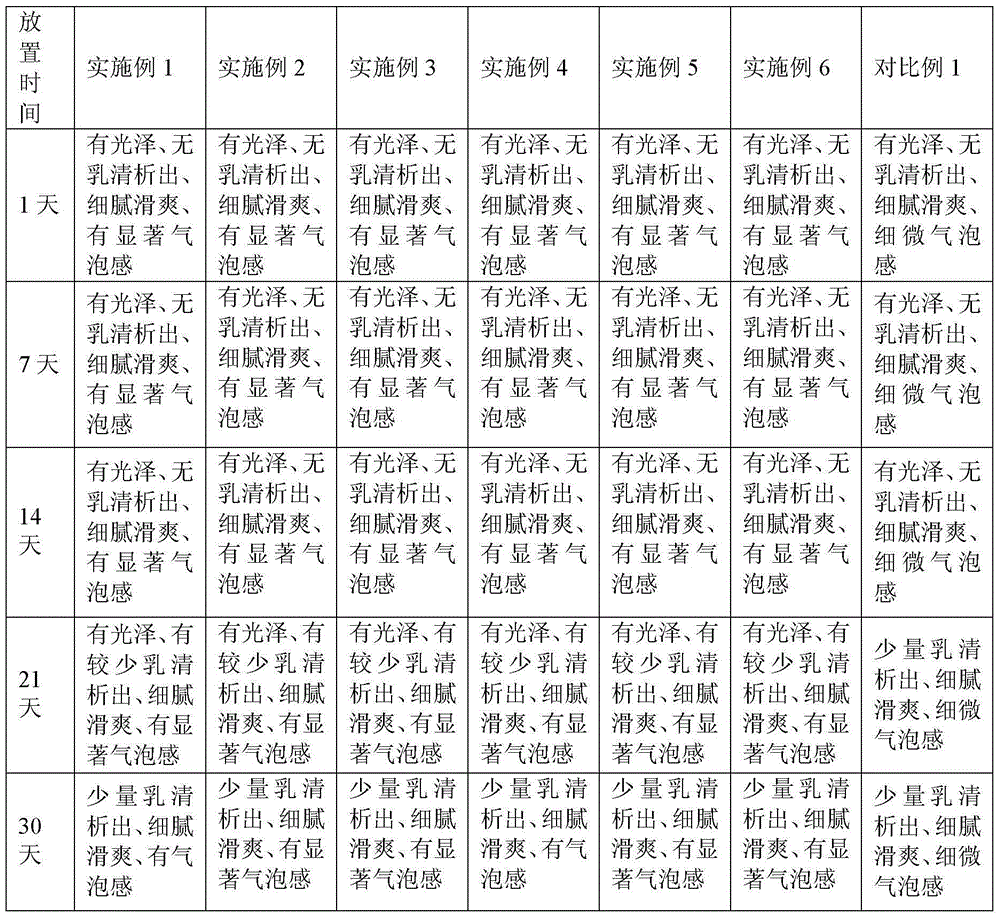Aerogenesis fermentation dairy product and production method thereof
A fermented milk product and fermented milk technology, applied in dairy products, milk preparations, applications, etc., can solve the problem of low gas production of lactic acid bacteria
- Summary
- Abstract
- Description
- Claims
- Application Information
AI Technical Summary
Problems solved by technology
Method used
Image
Examples
Embodiment 1
[0039] 1. Raw material formula (based on 1000g fermentation substrate):
[0040] Fermentation substrate: 90g of white sugar; 0.7g of sodium citrate; the rest of raw milk;
[0041] Mixed fermentation strains (Lactococcus lactis subsp. cremoris, Leuconostoc, Lactococcus lactis subsp. diacetyl and Lactococcus lactis subsp. lactis, mixing ratio=0.5:1:1:0.5): 0.008g.
[0042] 2. Production method:
[0043] 1. Stir and disperse the raw milk (fresh milk) and white sugar in the ingredients at a high speed of 65°C for 30 minutes to mix evenly, then add sodium citrate to obtain a milk mixture;
[0044] 2. The mixed material is degassed and homogenized at 65°C and 18MP pressure;
[0045] 3. The homogenized mixed material is sterilized at 95°C for 300s;
[0046] 4. Cool the sterilized material to 30°C, add fermentation strains, stir and mix evenly;
[0047] 5. Ferment at 30°C for 18 hours, the acidity reaches 74°T, stir to break the emulsion, cool down to stop the fermentation;
[00...
Embodiment 2
[0051] 1. Raw material formula (based on 1000g fermentation substrate):
[0052] Fermentation substrate: 60g of white sugar; 4g of starch; 0.2g of pectin; 0.8g of sodium citrate; the rest of raw milk;
[0053] Mixed fermentation strains (Lactococcus lactis subsp. cremoris, Leuconostoc, Lactococcus lactis subsp. diacetyl and Lactococcus lactis subsp. lactis, mixing ratio = 1:3:2:1): 0.009g; Lactobacillus bulgaricus : 0.002g; Streptococcus thermophilus 0.002g.
[0054] 2. Production method:
[0055] 1. Mix all the ingredients except for the strains at 70°C for 25 minutes at high speed to mix evenly;
[0056] 2. The mixed material is degassed and homogenized at 68°C and 20MP pressure;
[0057] 3. The homogenized mixture is sterilized at 110°C for 10 minutes;
[0058] 4. Cool the sterilized material to 35°C, add fermentation strains, stir and mix evenly;
[0059] 5. Ferment at 35°C for 14 hours, the acidity reaches 76°T, the emulsion is broken and the temperature is lowered t...
Embodiment 3
[0063] 1. Raw material formula (based on 1000g fermentation substrate):
[0064] Fermentation substrate: white sugar 40g; modified starch 2g; agar 0.2g; pectin 0.4g; sodium citrate 0.9g;
[0065] Mixed fermentation strains (Lactococcus lactis subsp. cremoris, Leuconostoc sp., Lactococcus lactis subsp. diacetyl and Lactococcus lactis subsp. lactis, mixing ratio = 1.5:4:2.5:1): 0.01g; Bacillus 0.005g.
[0066] 2. Production method:
[0067] 1. All the ingredients except for the bacteria were stirred and dispersed at 68°C for 25 minutes to mix them evenly;
[0068] 2. The mixed material is degassed and homogenized at 65°C and 20MP pressure;
[0069] 3. The homogenized mixed material is sterilized at 121°C for 4s;
[0070] 4. Cool the sterilized material to 37°C, add fermentation strains, stir and mix evenly;
[0071] 5. Ferment at 37°C for about 12 hours, and when the acidity reaches 78°T, break the emulsion and cool down to stop the fermentation;
[0072] 6. Pour the ferme...
PUM
 Login to View More
Login to View More Abstract
Description
Claims
Application Information
 Login to View More
Login to View More - R&D
- Intellectual Property
- Life Sciences
- Materials
- Tech Scout
- Unparalleled Data Quality
- Higher Quality Content
- 60% Fewer Hallucinations
Browse by: Latest US Patents, China's latest patents, Technical Efficacy Thesaurus, Application Domain, Technology Topic, Popular Technical Reports.
© 2025 PatSnap. All rights reserved.Legal|Privacy policy|Modern Slavery Act Transparency Statement|Sitemap|About US| Contact US: help@patsnap.com



